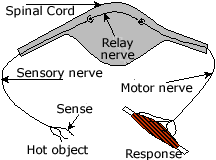Reflex action is a rapid automatic and involuntary response to a stimulus which is not under the control of the brain.
If we unknowingly touch a hot object, we immediately move our hand away from it. So moving our hand away on touching a hot plate is an example of reflex action.
A knee jerk, coughing, yawning, blinking of eyes, sneezing, salivation, movement of diaphragm during breathing are all examples of reflex actions.

REFLEX ARC
The nerve pathway involved in a reflex action is called a reflex arc.
If we unknowingly touch a hot object, this heat is sensed by a heat receptor (Thermo receptor) in our hand.
The receptor starts an impulse in a sensory neuron, which transmits the message to the spinal cord.
The impulse is passed to the relay neuron, which is in turn passes to motor neuron.
The motor neuron passes the impulse to a muscle in our arm.
The muscle of arm is an effector organ because it responds to the stimulus.
Stimulus → Receptor → Sensory neurons
↓
Effector organs ← motor neurons ← spinal cord
Dear students this is the diagram of reflex arc.

Dear students If diagram of reflex arc is asked
SENSE ORGANS
Animals have five sense organs.
1. Photoreceptor - respond to light……..eyes
2. Phonorceptor - respond to sound……ears
3. Olfactory receptor - respond to smell…….nose
4. Chemoreceptor - respond to chemicals…tongue
5. Thermo receptor - respond to heat ……..skin


2 comments:
Off course I have appreciated your manual work which you have prepared for students it's well understood particularly when you compare with Tanzanian syllabus for both O-Level and A-Level your materials are not differ.
Please reply me,Thanks
Mam please answer this question. What is the need for a system of control and coordination in an organism
Post a Comment